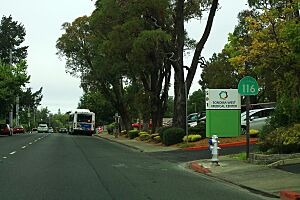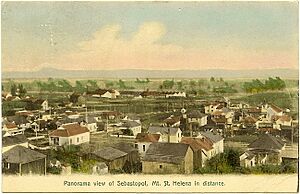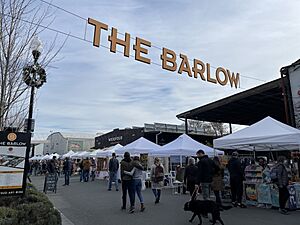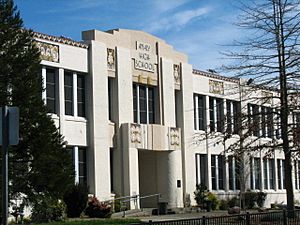Sebastopol, California facts for kids
Quick facts for kids
Sebastopol, California
|
|
|---|---|

Main Street in Downtown Sebastopol
|
|

Location in Sonoma County and the State of California
|
|
| Country | United States |
| State | California |
| County | Sonoma |
| Incorporated | June 13, 1902 |
| Named for | Siege of Sevastopol |
| Government | |
| • Type | Council–manager |
| Area | |
| • Total | 1.88 sq mi (4.87 km2) |
| • Land | 1.88 sq mi (4.87 km2) |
| • Water | 0.00 sq mi (0.00 km2) 0% |
| Elevation | 82 ft (25 m) |
| Population
(2020)
|
|
| • Total | 7,521 |
| • Estimate
(2023)
|
7,320 |
| • Density | 4,001/sq mi (1,544.4/km2) |
| Time zone | UTC-8 (PST) |
| • Summer (DST) | UTC-7 (PDT) |
| ZIP codes |
95472-95473
|
| Area code | 707 |
| FIPS code | 06-70770 |
| GNIS feature IDs | 277599, 2411857 |
Sebastopol (/sɪˈbæstəpoʊl, -puːl/ SIB-ast-Ə-pohl-,_--pool) is a city in Sonoma County, California. About 7,521 people lived there in 2020.
Sebastopol was once famous for growing plums and apples. Now, most of the old orchards are vineyards, where wine grapes are grown. A big shopping area called The Barlow has turned old farm buildings into cool places to eat, taste wine, and see art. This has made Sebastopol a popular spot in California's Wine Country.
A famous gardener named Luther Burbank had gardens here. The city also hosts fun events like the Apple Blossom Festival in April and the Gravenstein Apple Fair in August. It's also home to the Sebastopol Documentary Film Festival.
Contents
History of Sebastopol
How Sebastopol Got Its Name
The area was first called Pine Grove. The story of how it became Sebastopol is quite interesting! In the late 1850s, there was a big fight at a bar. Someone watching supposedly compared the fight to a long battle called the Siege of Sevastopol. This battle happened during the Crimean War (1853–1856). The old name, Pine Grove, is still used for a store downtown.
Early People and Settlers
The first people known to live here were the Coast Miwok and Pomo tribes. Sebastopol is built on top of several of their old village sites.
The town started in the 1850s with a post office. It became a small trading spot for local farmers. After the California Gold Rush (1848–1855), many new settlers came to California. More and more people moved to the rich valleys north of San Francisco to farm. Sebastopol's early residents came from many different countries. A large group of Chinese immigrants even created a Chinatown in the city center in the 1880s.
The Apple Era and Growth
Sebastopol became known as the "Gravenstein Apple Capital of the World." The apple business brought good times to the town. In 1890, the San Francisco and North Pacific Railroad connected Sebastopol to the national train system. The town officially became a city in 1902. It had schools, churches, hotels, and even an opera house.
However, the great earthquake of 1906 destroyed most of these early buildings. Sebastopol was only about 7 miles from Santa Rosa, which was hit very hard. But like other towns, Sebastopol was rebuilt. Studies show that Sebastopol felt some of the strongest shaking during that earthquake.
In 1934, the Enmanji Japanese Buddhist Temple was built. It was first shown at the Chicago World's Fair in 1933. This special temple was taken apart and shipped to Sebastopol. It was then put back together without using any nails!
Later in the 1900s, the apple business faced challenges. It became harder to compete with other places that grew apples. Many apple orchards were replaced by vineyards and new homes. Today, many people who live in Sebastopol travel to nearby towns like Santa Rosa for work and shopping.
Trains and Roads
Sebastopol used to have trains running right on Main Street. The tracks were removed in the late 1980s. Passenger train service stopped in the 1930s, and regular freight service ended in the late 1970s. Students from Analy High School even made a video about it in 1979!
The factories that processed apples are now gone from downtown. Vineyards and houses have replaced many apple orchards. This means there isn't much need for freight trains anymore. The last apple processing plant, Manzana Products, plans to move its operations by 2026.
Around the time the train tracks were removed, the Gravenstein Highway (Route 116) was changed. Main Street and Petaluma Avenue became one-way streets in the 1980s. This was done to help with the town's ongoing traffic issues.
Environmental Efforts
Sebastopol has been a leader in protecting the environment.
- In 1985, the city declared itself a nuclear-free zone. This means it does not allow nuclear weapons or power within its limits.
- The town does not use harmful chemicals (pesticides) in its city parks and gardens.
- In 2013, Sebastopol became one of the first cities in California to require solar panels on all new homes. This rule was later put in place across the whole state by 2020.
- Sebastopol also banned new gas stations, following the lead of a nearby city. Other cities in the area have done the same.
Housing and Growth
Sebastopol has rules to control how much the city grows. In 1994, it set an urban growth boundary. This line helps stop buildings from spreading too far outside the city. Residents voted to keep this boundary in place, most recently in 2016.
The city has also worked to create affordable homes for people who need them. This includes homes for low-income families and those without a permanent place to live. For example, in 2007, the city bought land to create Park Village. This is a mobile home park for long-term residents and people who used to be homeless. During the COVID-19 pandemic, an old hotel was turned into homes with support services. New affordable housing projects are also being built.
City's Money Challenges
In April 2021, Sebastopol faced a big challenge when $1.2 million was stolen from the city's bank accounts. This happened because of online fraud. The city was already expecting money problems, with a possible $2.9 million shortage by 2024.
To help with this, the city increased water and sewer rates by 37% in 2024. This decision caused some debate. The mayor was surprised that the city would charge interest on money moved between its own accounts.
Local residents voted in 2024 to add a small sales tax (half a cent). This tax would help prevent the city from spending more money than it has. If approved, Sebastopol's sales tax would be one of the highest in California.
Modern Farming and Food
Sebastopol is home to several well-known food and drink companies. These include Guayakí, Redwood Hill Creamery, Traditional Medicinals, and Bachan’s.
Cider makers have become popular in Sebastopol. This celebrates the city's history with the Gravenstein apple. Ace Cider started here in 1993. Golden State Cider, which uses local apples, opened a tasting room in The Barlow in 2019.
Sebastopol is also part of the Russian River Valley AVA, a famous wine region. Many wineries and tasting rooms are in the area. Some local places specialize in natural wine, which is made with very little added stuff.
As of 2024, Sebastopol has two restaurants that have received a "Bib Gourmand" award from the Michelin Guide. These awards are given to restaurants that offer great food at reasonable prices. The restaurants are Khom Loi and Ramen Gaijin.
Geography of Sebastopol
Sebastopol is located about 9 miles west of U.S. Route 101. The main roads that cross in downtown are State Route 12 and State Route 116 (Gravenstein Highway).
The city is on the edge of the Laguna de Santa Rosa. This is a wetland area that gets water from Santa Rosa Creek and other small streams. The Laguna is home to many different animals and plants. It also separates Sebastopol from Santa Rosa.
During winter, the Laguna often floods. This can close State Route 12 and sometimes flood businesses and homes on the east side of Sebastopol. Two rare species of plants, the Pitkin Marsh lily and White sedge, can be found near Sebastopol.
The city covers a total area of about 1.9 square miles, and all of it is land.
Population and People
| Historical population | |||
|---|---|---|---|
| Census | Pop. | %± | |
| 1880 | 197 | — | |
| 1910 | 1,233 | — | |
| 1920 | 1,493 | 21.1% | |
| 1930 | 1,762 | 18.0% | |
| 1940 | 1,856 | 5.3% | |
| 1950 | 2,601 | 40.1% | |
| 1960 | 2,694 | 3.6% | |
| 1970 | 3,993 | 48.2% | |
| 1980 | 5,595 | 40.1% | |
| 1990 | 7,004 | 25.2% | |
| 2000 | 7,774 | 11.0% | |
| 2010 | 7,379 | −5.1% | |
| 2020 | 7,521 | 1.9% | |
| 2023 (est.) | 7,380 | 0.0% | |
| U.S. Decennial Census 2020 |
|||
| Racial and ethnic composition | 2000 | 2010 | 2020 |
|---|---|---|---|
| White (non-Hispanic) | 85.35% | 81.87% | 74.66% |
| Hispanic or Latino (of any race) | 9.26% | 11.99% | 14.36% |
| Two or more races (non-Hispanic) | 2.32% | 2.59% | 6.18% |
| Asian (non-Hispanic) | 1.49% | 1.57% | 2.43% |
| Other (non-Hispanic) | 0.23% | 0.19% | 0.96% |
| Black or African American (non-Hispanic) | 0.64% | 0.92% | 0.82% |
| Native American (non-Hispanic) | 0.62% | 0.62% | 0.40% |
| Pacific Islander (non-Hispanic) | 0.09% | 0.24% | 0.19% |
Population in 2020
The 2020 United States Census counted 7,521 people in Sebastopol. Most residents (80.8%) were White. About 12.7% of the population was Hispanic or Latino.
Population in 2010
In 2010, Sebastopol had 7,379 people. About 88.2% of the people were White. About 12.0% were Hispanic or Latino.
Most people (98.3%) lived in homes, not in institutions. There were 3,276 households. About 27.5% of these households had children under 18. The average household had 2.21 people. The average family had 2.82 people.
The population was spread out by age. About 20.5% were under 18. About 17.4% were 65 or older. The average age was 46.1 years.
The median income for a household in the city was $60,322. This means half of the households earned more, and half earned less. The median income for a family was $74,020.
Population in 2000
In 2000, there were 7,774 people living in Sebastopol. The population density was about 4,139 people per square mile. The racial makeup was mostly White (89.85%). About 9.26% of the population was Hispanic or Latino.
There were 3,250 households. About 31.8% of these had children under 18. The average household size was 2.33 people. The average family size was 2.95 people.
The median age was 42 years. The median income for a household was $46,436. About 6.9% of the population lived below the poverty line.
Arts and Fun Things to Do
Here are some interesting places to visit in Sebastopol:
- Sebastopol Center for the Arts: A place for art and creativity.
- Luther Burbank's Gold Ridge Experiment Farm: You can visit the gardens of the famous horticulturist.
- Guayaki Sustainable Rainforest Products world headquarters: Learn about this company that focuses on sustainable products.
- The historic Hogan Building: This old stone building was once a power station for an electric railway. It was one of the few buildings to survive the 1906 earthquake!
- West County Museum: Learn about the history of western Sonoma County here. It's in an old train station.
- George A. Strout House: A historic house.
- Ives Park: A park where the Sonoma County Repertory Theater performs in the summer.
- Ragle Ranch Regional Park: A large park for outdoor activities.
- Joe Rodota Trail and West County Trail: Paths for walking and biking.
- Laguna de Santa Rosa: A beautiful wetland area for nature lovers.
- Sebastopol Community Cultural Center: A hub for community events.
- The Barlow: An outdoor shopping area with dining, tasting rooms, and art.
Schools in Sebastopol
Sebastopol has several school districts. The main ones are Sebastopol Union Elementary School District and West Sonoma County Union High School District. These districts cover the city limits. Other districts serve the areas just outside Sebastopol.
Analy High School is the main high school for grades 9-12. It serves students from Sebastopol and the wider west Sonoma County area. The high school district also has Laguna High School, which is a special school for students who need a different learning path.
Sebastopol Union operates two elementary schools: Park Side (for younger students, TK-4) and Brook Haven (for older elementary and middle school students, 5-8).
The Sebastopol Charter School is a public Waldorf charter school for K-8 students. The Twin Hills Union School District also sponsors the K-8 SunRidge Charter School in the city.
City Services
Police Department
The Sebastopol Police Department helps keep the city safe. It has 31 police officers and staff, plus 25 volunteers. The department started in the early 1900s.
Famous People From Sebastopol
Many interesting people have lived in or are connected to Sebastopol:
- Luther Burbank: A famous gardener.
- Les Claypool: Bass player and singer for the band Primus.
- Peter Coyote: A narrator, author, and actor.
- Jerry Garcia and Mickey Hart: Members of the band Grateful Dead.
- Peter Krause: An actor.
- Willard Libby: The inventor of carbon dating, who went to Analy High School.
- Megan McDonald: A children's book author, known for the Judy Moody series.
- Charles M. Schulz: The cartoonist who created Peanuts.
- Rider Strong: An actor.
- Tom Waits: A singer, songwriter, and musician.
Sister Cities
Sebastopol has special friendships with two cities in other countries:
 Chyhyryn, Ukraine
Chyhyryn, Ukraine Takeo, Japan
Takeo, Japan In Spanish: Sebastopol (California) para niños
In Spanish: Sebastopol (California) para niños








